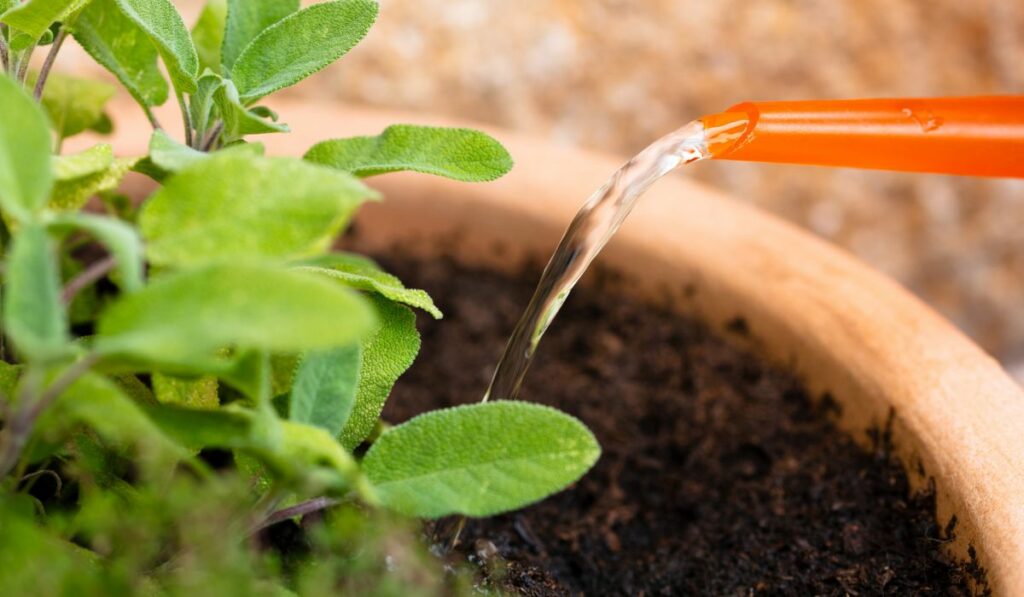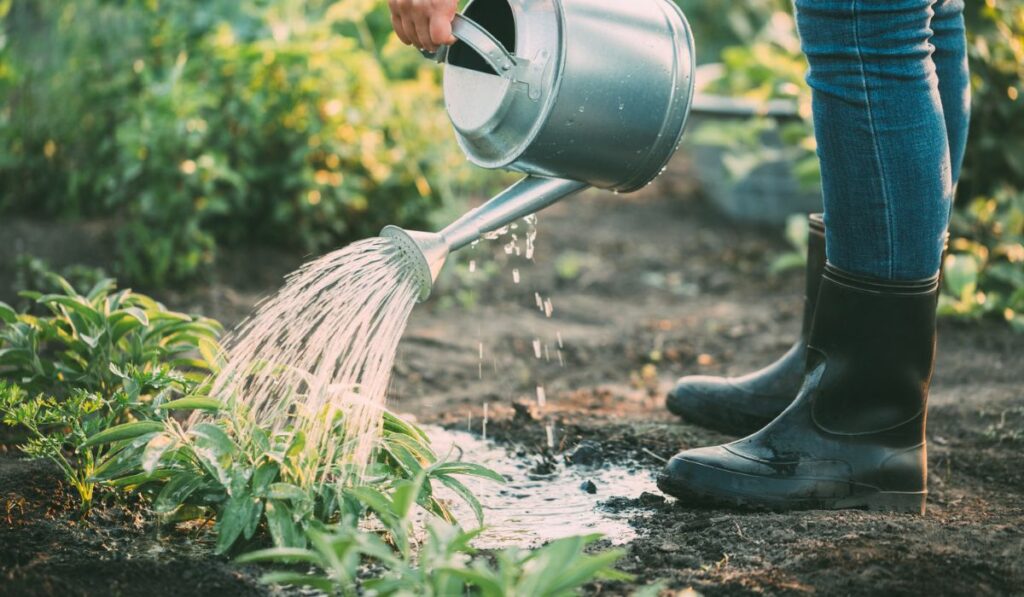For many people, sage is a classic kitchen staple synonymous with chicken or turkey seasoning. But this herb is so much more than that! Originating from the Mediterranean, sage (salvia Officinalis) has been used in cooking, medicine, and even magic for centuries. It’s a relatively low-maintenance herb, but it does need some basic care to stay healthy, including watering. So, how often should you water sage?
Sage plants need just 1 inch of water per week, so a thorough watering once a week should suffice. If the weather is particularly hot or dry — or if your sage is still young — you may need to water it more frequently. You can tell your sage needs water when it gets droopy or the soil turns dry.
Sage is one of the most commonly grown herbs in American gardens, and it’s also one of the most easy to grow. So whether you have a green thumb or not, keeping a pot of sage on your windowsill is practically foolproof. But it’ll still need some watering. Let’s look at how often you need to water sage and some tips on growing this versatile herb.
What Is Sage?
Sage (Salvia officinalis) is a perennial evergreen shrub in the mint family. It’s native to the Mediterranean region and has been naturalized to other parts of the world, including parts of Europe, Asia, Africa, and North America.
Sage is a woody shrub with gray-green leaves and purple or white flowers. The leaves are aromatic, just like plants in the rosemary family. The flowers attract bees, and the leaves are used as a spice in cooking.
Sage has a long history of use in folk medicine and is still used today as an herbal remedy to treat various conditions. It’s thought to have antibacterial, anti-inflammatory, and antioxidant properties. In culinary use, sage is used as a seasoning for meat, poultry, and stuffings. It is also used to make sage tea.
Growing sage is relatively easy, and it’s a hardy plant that can tolerate a wide range of growing conditions. It prefers full sun but will also grow in partial shade.
Sage is tolerant of most soil types as long as it is well-drained. It can reach up to two feet in height and can live for several years with proper care.
Do Sage Plants Need a Lot of Water?

Sage is a drought-tolerant plant that only needs a little water to stay alive. One inch of water per week should be plenty. But this isn’t set in stone — you might need to adjust your watering schedule according to different conditions. Let’s discuss a few:
Climate
If it’s particularly hot and dry where you live, your sage will need more water than usual. The same goes for if it’s very windy, since this can cause the soil to dry out faster. On the other hand, if you get plenty of rain, you might not need to water your sage as often.
Location
Where you plant your sage makes a difference too. If it remains in full sun all day, it’s going to need more water than if it’s in partial shade. Sage plants kept indoors often don’t get direct sunlight, so they need much less water. Plus, if you’ve grown a cluster of sage plants, they will compete for water and need more frequent watering.
Growth Stage
Young seedlings have shallow roots and need constant moisture to survive. So if you just planted your sage, water it every day or two. Once it becomes established, you can reduce the watering to every few days or once a week.
Similarly, spring and summer are the sage’s growing seasons, so it will need more water during this time. In fall and winter, when growth has slowed, you can water less often.
Type of Container
Plants grown in pots generally need more water than plants in the ground. This is because the roots are confined to a small space, so the soil dries out more quickly. The type of containers also makes a difference.
Clay pots, for example, are more porous than plastic pots, so they tend to dry out faster. Plastic containers, on the other hand, can cause the roots to rot if they don’t have drainage holes.
Soil
Sage grows best in sandy, well-drained soil. If your soil is heavy or clay-like, it will hold moisture longer, and you’ll have to be very careful not to over-water. If your soil is very sandy, on the other hand, it might dry out too quickly, and you’ll need to water more often.
Can You Overwater Sage?
Yes, in fact, it’s pretty easy to overwater sage. Sage is a drought-resistant plant and is sensitive to too much water. If you water too often or the soil or container doesn’t have good drainage, it can quickly become waterlogged, and the roots will start to rot.
New gardeners often like to sprinkle their plants with water every day, but this usually isn’t necessary and can actually do more harm than good. When it comes to sage, under-watering is much better than overwatering.
What Does Overwatered Sage Look Like?

Overwatered sage looks wilted and lifeless, even when it’s not hot or dry outside. The leaves will be droopy and may turn yellow or brown with black spots. Other symptoms include stunted growth, leaf edema, soft stems, root rot, and fungal diseases.
If you think your sage is showing signs of overwatering, feel the soil. If it’s soggy or waterlogged, you need to cut back on watering. Let the soil dry out completely before watering again. If the roots have already started to rot, you might need to replant your sage in fresh, well-drained soil.
Other Tips for Growing Sage
Growing sage isn’t difficult at all. Follow these key tips, and you’ll be on your way to a thriving plant.
- Sage loves full sun; in fact, the best aroma and flavor come from plants that get at least six hours of direct sunlight a day. So choose a location in your yard that gets plenty of sunlight.
- You can grow sage from seeds (on Amazon), cuttings, or layering. However, growing from seed can be tricky, and it takes a long time for the plant to mature. So unless you’re very patient, it’s probably best to start with cuttings or divisions.
- You can grow sage in-ground or in containers, but the plants do best in containers. It’s more convenient, and you can better control the size of the plant and watering needs. Just make sure the container has drainage holes to avoid root rot.
- Sage doesn’t need any fertilizer or special soil, but you can give it a little boost with some compost or manure. Just mix it into the top few inches of soil before planting.
- Regularly water your sage during early growth but once it’s established, cut back on watering. And only water when the soil is dry to the touch.
- Sage is an evergreen shrub, so you can harvest “on need” basis. However, do a hard pruning twice a year to encourage new growth and stop the plant from getting too woody.
- Sage is fairly resistant to pests and diseases. The major problems are root rot, powdery mildew, and caterpillars. But they can be easily controlled by using the right products or organic methods.








